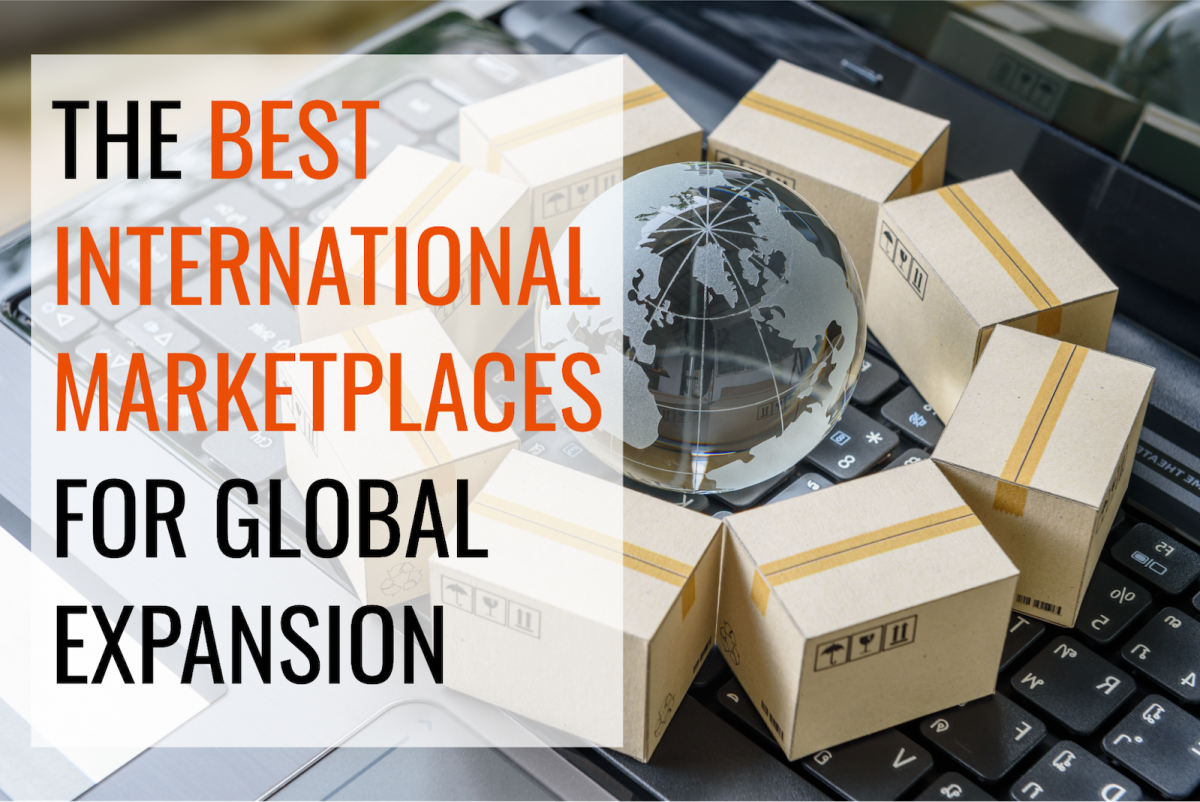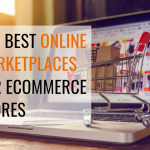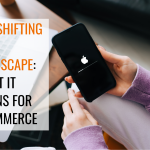If global expansion has been on your mind, now could be a great time to get started.
While Amazon Global is the natural first step, especially if you are already selling on Amazon U.S. since they have teams that can help get everything set up for various international markets, making your mark on other marketplaces as well will put you at the forefront of your desired audience.
Did you know that Asia-Pacific is the largest market for retail ecommerce sales? In 2021, digital sales in the region amounted to nearly $2.992 trillion, versus the $870 billion in ecommerce sales in the U.S. This year, that figure is estimated to grow three times bigger than that of North America.
The rest of the world is also ripe for opportunities. The European Union is the third-largest market, with $844 billion in sales for 2021. Latin America, India, and Southeast Asia are registering double-digit ecommerce sales growth. If you’re selling solely in the U.S., you could be missing out on additional revenue. Thanks to the internet and better logistics options, selling from one side of the world to another has become accessible to online stores of all sizes.
In this article, I’ll walk you through some important things you need to know before you expand your ecommerce business through international marketplaces. I’ll also share with you a list of some of the top marketplaces in Europe, Asia, and Latin America. Let’s dive in.
What to Do Before Selling Internationally
Selling on international marketplaces can multiply your profits, reach a new and influential audience, and provide your customers with a better shopping experience. However, there’s more to it than setting up a seller account and doing business right away.
Serial entrepreneur Steven Carpenter writes in TechCrunch, “When 25 percent or more of your business is coming from international markets, it’s time to scale outside your home country. Before doing anything, you must understand market attractiveness, product readiness, and business drivers.”
Companies should treat business expansion as a new business opening. You’d have to do a good amount of research, planning, and laying down the groundwork before you can finally launch.
Before you take your online business on the world stage, here are some key steps you need to take:
Conduct Local Market Research
Understanding a new market is the critical first step if you want to find success in your expansion efforts. Look beyond the market size and research which countries and regions will be the most receptive to your products. Start your market research with free tools like Google Trends and Answer the Public, then dive deeper with focus group discussions, interviews, and market segmentation research.
You can also check out secondary sources of market research data such as company reports of your competitors and industry statistics from Statista, Pew, or Forrester. White papers, trade magazines, and market research companies publish data from third-party agencies about a certain industry.
Next, do a product gap analysis to see if there are gaps in the market that aren’t satisfied by local products. Check out the competition and run a SWOT analysis to see what can differentiate your product from local players.
Create an International Business Plan
Cultural, governmental, and economic conditions affect how a market reacts to a product. What works in North America may not work in European countries and vice versa. Create a local strategy that takes all of the local nuances into account, while at the same time staying in line with your overall corporate image and strategy.
Your business plan should include:
- Demographics of your target audience and customer personas
- Reasonable short-term and long-term goals and other ecommerce metrics
- Marketing and operational plans and budgets
- Cost-efficient international logistics and shipping strategies so that you can handle global orders without losing profit on shipping and fulfillment charges
(Source: eMarketer)
Start Hiring People
Expansion equals more workload, which means you’ll probably need to hire people or outsource some business processes. When expanding abroad, work with people who have knowledge of the local market. You’ll get a much better feel of the local business landscape and save time figuring out the cultural and legal particularities of each country.
Consider Legal and Tax Implications
Doing business in another country also means dealing with local taxes and legalities. Set up the right finance infrastructures when it comes to tax filing and income reporting to avoid trouble down the road. Start establishing relationships with local banks, prepare your sales report, tax, and VAT templates (if you’re expanding into European markets), and set a risk management plan.
Get Yourself Financially Ready
Entering a new market can boost revenue, but it also comes with financial risks. Remember that business expansion comes with initial costs that could eat into your total bottom line. When selling in a new market, consider:
- Customer acquisition costs and ad spending
- Landed cost of merchandise, or how much you’ll spend to get the product to your customer’s doorstep; this includes the cost of goods, transportation, packaging, insurance, customs and taxes, and currency conversion
- Paying for additional services like local payment methods, local warehouses, and local staff
10 International Online Marketplaces Worth Expanding Into
Ready to expand beyond Amazon and eBay?
Here’s a list of some of the world’s most popular online marketplaces that will help your business get in front of millions of potential customers:
Alibaba and AliExpress
The Alibaba Group owns some of the top online marketplaces in China. Two of its biggest sites are Alibaba.com for B2B wholesale businesses and Aliexpress.com for B2C businesses. The entire group has over one billion annual active customers. Aliexpress has over 600 million mobile app downloads and brings in 200 million visitors in a month. It has a presence in 230 countries and regions and is available in 18 languages.
(Source: AliExpress)
TMall Global
TMall is another ecommerce website from the Alibaba group. It’s positioned as Alibaba’s platform for cross-border selling, a convenient way for foreign sellers to reach Chinese customers without having to establish Chinese operations. Popular product categories include beauty and personal care, apparel, homeware, electronics, and health and wellness items.
(Source: TMall Global)
Rakuten
Rakuten is a Japanese online retailer that’s gone global and now serves over 1.6 billion members in 30 countries and regions. Aside from Asia, they also have a huge presence in the UK, Germany, and France.
There’s a wide variety of product categories, from apparel, electronics, cosmetics, pet supplies, and even vacations. Brands have the flexibility to customize their storefronts, allowing them to stand out and create their own identity. Vendors can handle customer service and inventory, giving them more control and opportunities to develop better customer relationships.
(Source: Rakuten)
Shopee
Shopee is a Singapore-based start-up and the current leading ecommerce platform in Southeast Asia, with 343 million visits per month. It has a huge presence in Indonesia, Vietnam, Taiwan, Philippines, Thailand, and Malaysia. It’s a platform designed with a mobile-first concept in mind, as Southeast Asians are the most engaged mobile users in the world. The region has 360 million internet users and 90% of those stay connected via their mobile phones.
Shopee says that 95% of their sales come from mobile. Shopee takes a hyper-local approach for each country, with localized initiatives that help online sellers keep up with local customs, holidays, and country-specific payment options.
Get our The Best International Marketplaces for Global Expansion - Worksheet delivered right to your inbox.
(Source: Shopee)
Flipkart
Flipkart started as a direct-to-consumer business before becoming India’s top online marketplace. Flipkart raked in a gross merchandise value (GMV) of around $15 billion in 2021, ahead of its rival Amazon India.
The most popular items on Flipkart are mobile phones, fashion apparel, and appliances. After a surge in digital adoption in the last two years, India has a booming ecommerce economy that’s worth over $55 billion GMV in 2021. It’s set to reach $200 billion by 2026. The country’s improved economic performance, young demographic, increased mobile phone use, and better internet penetration make it an expansion market that’s worth looking into.
(Source: Flipkart)
Zalando
Zalando was founded in Germany in 2008 and is currently a top online marketplace for fashion items. It’s a popular shopping destination in the United Kingdom and in European countries like Germany, France, the Netherlands, Spain, and Italy. It serves more than 48 million active customers in 23 markets.
Zalando Plus, their membership program, helps them attract and keep customers. In 2021, the fashion giant made €10.4 billion in revenue and is on track to reach more customers and sales by 2025.
(Source: Zalando)
Cdiscount
Cdiscount is the second largest marketplace in France, just after Amazon, and is widely used by European customers. Cdiscount has over 40 different categories that include homeware, electronics, sports equipment, apparel, healthcare, and many others. The most popular items on Cdiscount are consumer electronics.
Cdiscount’s market is growing, with 23 million unique visits per month and 10.2 million active customers in Germany, Belgium, Luxembourg, Italy, and Spain. On CDiscount, you can sell to both B2B and B2C customers. It has a well-developed logistics network, its own fulfillment service, and a loyalty program.
(Source: CDiscount)
Mercado Libre
Mercado Libre is a great place to tap into the booming ecommerce market in Latin America. It’s the number one popular marketplace in the region, selling to over 65 million buyers across 18 countries. The six biggest markets in the region are Brazil, Mexico, Colombia, Argentina, Chile, and Peru.
Mercado Libre offers seller support like logistics and shipping solutions, language translation features, international payments converting dollars to local currencies, and advertising solutions.
(Source: Mercado Libre)
Linio Mexico
Linio is a popular online marketplace from Mexico and is now present in four other Latin American countries. Linio makes over $220 million annually in revenue, receives 24 million website visits, and has over 10 million products in its catalog. They make global selling easier with local customer service and operations teams, preferential shipping rates, easy payment systems, and English-speaking support staff.
(Source: Linio Mexico)
FAQs About International Ecommerce
How can ecommerce businesses be expanded globally?
You can expand your ecommerce business globally in several ways. First is through product exportation, which means your business sells products through a distributor or retailer in the country you want to expand into. The second is through licensing arrangements, or allowing another company or organization in a foreign country to use your intellectual property.
Examples of licensing agreements are franchising and private labeling. Another way is through partnerships with established local companies within a specific country. A fourth way to expand your company is through mergers and acquisitions of local businesses. The fifth is to enter new markets by selling on international marketplaces.
Which country has the biggest ecommerce market?
China is the world’s biggest ecommerce market, with online annual sales amounting to $2.78 trillion. The Chinese market makes up 52% of global online retail sales.
How big is the online retail industry?
The online retail industry is worth $4.9 trillion.
The Next Steps: Expanding Into an International Online Marketplace
Step One: Choose The Right Marketplace
When it comes to selecting the right marketplace, the top four things you need to consider are:
- Audience – You want to get your products in front of audiences who resonate with them the most. A large marketplace may have more users, but that also means stiff competition among sellers.
- Affordability – Pay attention to the fees and see how this will impact your budget and bottom line.
- Promotional Features – A marketplace with good SEO and ad solutions can help boost your visibility and sales.
- International Selling Features – Look for a marketplace that makes cross-border selling easier with features like English-speaking seller support, translation functions, currency converters, and payment solutions.
Step Two: Create a Mobile-First Experience
If you want to expand in the Latin American and the Asia-Pacific regions, always have mobile user experience in mind. The use of smartphones for online shopping is twice as prevalent in Asia than anywhere else in the world. In Latin America, more than half of the total online retail sales this year will be made through mobile. Be sure to use photos, copy, and product descriptions that look great on a smartphone.
Expansion is the key to any businesses’ growth and survival, but there are many factors you’ll want to consider before investing time and money in a new market. Be sure to research diligently and be prepared so that you, your team, and your company can find success in international marketplaces.
Need help planning your ecommerce global expansion strategy? Reach out for your FREE consultation call and let’s find solutions that’ll help you to get to the next stage of your business’ growth.
Get our The Best International Marketplaces for Global Expansion - Worksheet delivered right to your inbox.






